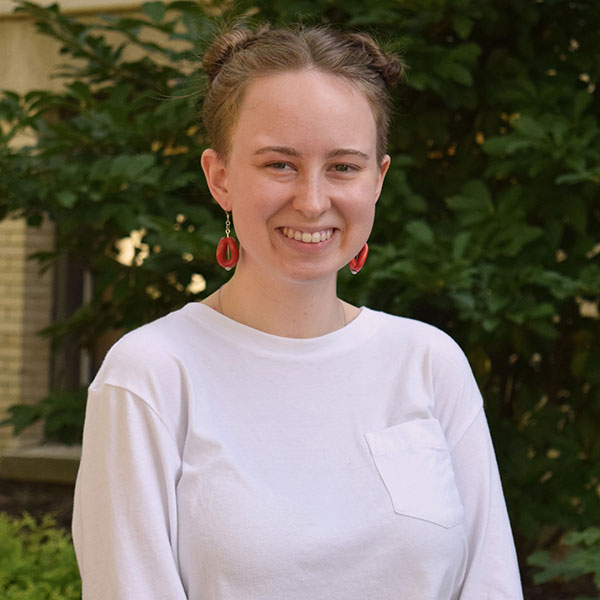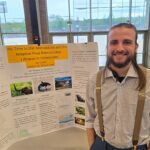
The Fading of Intention: Photodegradation Studies of Carmine Colorants and Their Implications in Art Conservation

Name: Megan E. Zins
Major: Chemistry
Minor: Art History
Advisors: Dr. Sarah J. Sobeck
Cultural heritage objects are irreplaceable objects that have artistic, historical, and/or cultural value and are subject to changes over time which may alter the identity of the object and its affect on viewers. Because these objects and artworks are irreplaceable, it is pertinent to understand these changes so that they can be mitigated. This thesis examines the effect and affect of the loss of color in works of art, both on a chemical and visual level. Specifically, the light sensitivity of carmine colorants are compared in its red and purple dye solutions and the carmine pigment form used in paints. Analytical methods including UV-visible and fluorescence spectroscopy, HPLC-DAD, LC-QTOF-MS, and computational modeling are employed to understand the photophysical and photochemical processes occurring on the molecular level, resulting in fading. It is observed that both dye forms and paint break down into smaller organic molecules that absorb UV light, but on significantly different timescales and through different mechanisms. Similar excited state processes are observed for the red and purple dyes, suggesting that the differing stabilities of the dyes is mainly due to their different protonation states. These chemical findings are then put into context through consideration of a case study featuring portraits painted by British portraitist Sir Joshua Reynolds which display extensive fading of carmine paint. It is concluded that the faded carmine in Reynolds’ works severely alters the identity and affect of the portraits, making their conservation more urgent and imperative.
Posted in Comments Enabled, Independent Study, Symposium 2022 on April 26, 2022.
21 responses to “The Fading of Intention: Photodegradation Studies of Carmine Colorants and Their Implications in Art Conservation”
Related Posts
Related Areas of Study
Chemistry
Access to labs, research opportunities, and small classes give chemistry majors lots of options after graduation.
Major MinorArt - Art History
Explore the cultural and historic significance of art and artists while building research and analytical skills.
Major Minor


Hi Megan! This is amazing, and so insightful! You’ve explained the chemistry / conservational methods and takeaways so well, which I appreciate as someone who doesn’t know much about the technical aspects. Conservation is super important for sure, so thank you for tackling this project—and completing it with flying colors! Fantastic job!! 😀
Hi Dante! It is so great to hear from you. Thank you so much for your kind words; they truly mean a lot to me. I also appreciate your pun haha 🙂
Sure thing! Oh wow! I didn’t even mean to make a pun! Haha
What a great video! So proud of you for all that you have accomplished this year with IS! It was so fun to share a lab space with you.
Congratulations on a really superb presentation, Megan! I even think I may finally understand the (basic) chemistry involved. It will be interesting to see how digital technologies, and other tools not yet invented, will continue to shape art conservation and its ethics. It’s been a great pleasure watching you develop this project, and now seeing such a wonderful presentation of it!
Great video, Megan! Excellent overview of the project’s interdisciplinary nature for a broad audience. I look forward to talking more about the chemistry you worked on soon!
Hi Grace Anne! Thank you so much! I have enjoyed seeing your growth throughout the process of IS too. I have also loved sharing a lab space with you as well!
Hi Dr. Siewert! Thank you so much for these kind words as well as helping me to develop my thesis. I am very happy that my presentation was able to convey the chemistry well to you! I am also excited to see the growth of art conservation, especially now that I am becoming a part of it.
Hi Dr. Feierabend! Thank you so much! I am also very excited to share my chemistry work with you later this afternoon 🙂
What a fabulous project and an outstanding presentation, Megan! The interdisciplinarity of your project is exemplary. I especially appreciate how accessible you made the chemistry for the lay audience. Were you able to visit the CMA to see Reynolds’ Portrait of Amabel and Jemima Yorke in person? Congratulations on a stunning conclusion to your senior year!
Congratulations on the Best Blend of Art and Science prize! It is well deserved.
Hi Dr. Cosgriff! It is such an honor to have your comments on my page. Thank you very much for your kind words! Yes, I was able to see Reynolds’ Portrait of Amabel and Mary Jemima Yorke in person, and it is truly a haunting experience! Thank you again!
Hi Dr. Faust! Thank you so much! I am glad you think so 😀
Lovely presentation Megan! It has truly been an honor to work with you this year! I look forward to seeing your continued work as you advance in the field.
Hi Dr. Sobeck! The honor is all mine. Thank you so much for your encouragement and belief in my abilities both within the context of IS and beyond.
🔥🔥🔥🔥
YOU GO GIRL
OMG 😱
🔥🔥🔥🔥
😋😘😫😍
🔥🔥🔥🔥
YOU GO GIRL
OMG 😱
🔥🔥🔥🔥
😋😘😫😍
YESSIR
As parents, we are just a wee bit biased, but are so proud of all your hard work on this IS. We also agree, with many others, that you have great aptitude for explaining this most difficult of subjects to allow us lay people to understand. Great job, Megan!
As parents, we are just a wee bit biased, but are so happy for all your hard work on this IS. We also agree, with many others, that you have great aptitude for explaining this most difficult of subjects to allow us lay people to understand. Great job, Megan!
Hey Nate, thank you so much for flooding my comment section with emojis lol
Thank you so much Mon (Mom) and Dold (Dad)!!! I’m glad you got something out of the presentation!! I appreciate all your love and support 🙂